Aysén Region
The Aysén del General Carlos Ibáñez del Campo Region[2][3] (Spanish: Región de Aysén, pronounced [ajˈsen], or Región de Aysén del General Carlos Ibáñez del Campo),[4][5] often shortened to Aysén Region or Aisén,[4] is one of Chile's 16 first order administrative divisions. Although the third largest in area, the region is Chile's most sparsely populated region with a population of 102,317 as of 2017.[6] The capital of the region is Coihaique, the region's former namesake.
Región Aysén del General Carlos Ibáñez del Campo Región Aysén del General Carlos Ibáñez del Campo | |
|---|---|
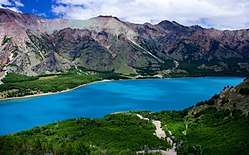 Patagonia National Park | |
 Flag  Coat of arms | |
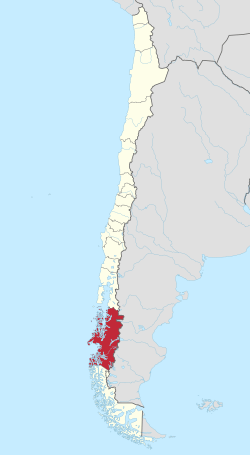 Map of Región Aysén del General Carlos Ibáñez del Campo | |
| Coordinates: 43°34′12″S 72°03′58″W | |
| Country | |
| Capital | Coyhaique |
| Provinces | |
| Government | |
| • Intendant | Geoconda Navarrete (Evopoli) |
| Area | |
| • Total | 108,494.4 km2 (41,889.9 sq mi) |
| Area rank | 3 |
| Highest elevation | 4,058 m (13,314 ft) |
| Lowest elevation | 0 m (0 ft) |
| Population (2017 census) | |
| • Total | 102,317 |
| • Rank | 16 |
| • Density | 0.94/km2 (2.4/sq mi) |
| ISO 3166 code | CL-AI |
| HDI (2017) | 0.779[1] high |
| Website | Official website (in Spanish) |
The landscape is marked by several glaciations that formed many lakes, channels and fjords. The region contains icefields including the Northern Patagonian Ice Field and the Southern Patagonian Ice Field, the world's third largest after those in Antarctica and Greenland. Laguna San Rafael National Park, reachable only by boat or plane, is one of the region's most popular tourist destinations. Until the construction of Route 7 (the Carretera Austral, or Southern Highway) in the 1980s, the only overland routes from north to south through the region were extremely primitive tracks.
Demography
Region XI, Aysen del General Carlos Ibanez del Campo, is the least populated of the country. According to the 2002 census there were only 91,492 inhabitants in an area of 106,990.9 km². The population density is 0.85 inhabitants per km². For the time elapsed since the last census to date, an average growth rate of 0.9 per 100 inhabitants has been estimated.
The largest cities according to the 2002 census are Coyhaique (population 44,850), Puerto Aysen (16,936), Chile Chico (3042), Puerto Cisnes (2517), Cochrane (2217), Melinka (1411) and Mañihuales Villa (1401).
Climate
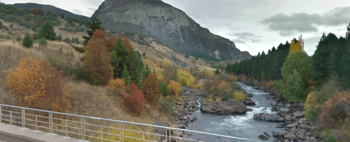
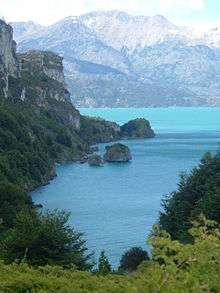
Aysén Region climate's is classified as a cool oceanic climate with low temperatures, abundant precipitation and strong winds.[7] The relief found throughout the region results in different types of climate zones in the western and eastern parts.[7] There are 4 distinct climate zones found within the region.[8][9] Coastal areas to the west have a cool temperate climate.[8][9] The coastal areas receive abundant precipitation throughout the year with mean annual precipitation that can reach 4,000 millimetres (157 in).[8][9] For example, Puerto Aysen receives 2,940 mm (116 in) of precipitation per year while on San Pedro Island, it receives 4,266 mm (168.0 in).[7] Most of the precipitation are associated with strong winds from the northwest and the north.[8][9] The winter months are usually the wettest months.[8][9] Mean annual temperatures are between 8 to 9 °C (46.4 to 48.2 °F) with January being the warmest month.[7] Temperatures decrease with latitude although owing to maritime influence which is reinforced with strong westerly winds throughout the year, temperatures are not extremely low compared to inland areas.[8] As a result, mean temperatures rarely fall below 4 °C (39.2 °F) in the coldest months, while the diurnal range is small, averaging 5 to 7 °C (9.00 to 12.60 °F).[8][9] Owing to the high precipitation year-round, relative humidity is high, averaging 87% with no months averaging below 80%.[8][9] High cloud cover dominates the coastal areas year round.[8]
In more inland areas to the east (about 40 km (25 mi) to the east of the coastal areas), precipitation is much lower, averaging 730 mm (29 in) in Cochrane to 1,200 mm (47 in) in Coyhaique.[8] Precipitation is the highest from May to August, which receives 50% of the annual precipitation.[8][9] During periods of cold temperatures, precipitation can fall as snow during these months.[8][9] Being located inland and farther away from the maritime influence, the climate is more continental than coastal areas.[8][9] Mean temperatures average between 8 to 10 °C (46.4 to 50.0 °F) which tends to be 1 or 2 °C (1.80 or 3.60 °F) lower than coastal areas at the same latitude.[8][9] With lower precipitation, relative humidity is lower, averaging between 71% to 74% in Cochrane and Coyahique respectively.[8] Cloud cover is lower and there are more clear days in inland areas than coastal areas.[8]
Corresponding to the Northern Patagonian Ice Field and the Southern Patagonian Ice Field, which are located at higher altitudes, temperatures are cold enough to maintain permanent ice fields.[8] These two ice fields receive abundant precipitation year-round, particularly in the west facing slopes of the Andes that descend to the ocean and fiords.[8][9] The climate is very windy.[8] No meteorological stations exist in the ice fields so it is estimated that the average high, average low and mean temperatures are below 0 °C (32.0 °F) in all months to maintain permanent ice fields.[8]
The easternmost parts of the region have a cold steppe climate.[8][9] Precipitation is significantly lower than the other parts of the region with mean monthly precipitation below 40 mm (1.6 in).[8][9] Precipitation is concentrated from May to August where these months are responsible for 55% to 65% of the total annual precipitation.[8][9] Snowfall can occur during these months owing to colder temperatures.[8][9] Mean annual precipitation ranges from 300 mm (12 in) in Chile Chico to 612 mm (24.1 in) in Balmaceda.[8] Mean temperatures are lower than areas to the east, averaging between 6 to 8 °C (42.8 to 46.4 °F).[8] Mean summer temperatures can exceed 15 °C (59.0 °F) in Chile Chico, which permits agriculture, similar to the one in the central parts of the country.[8] This is due to the moderating influence of General Carrera Lake which prevents temperatures from dropping too low.[8][9] The vegetation is mostly shrubs owing to the low temperatures and precipitation.[8][9] Relative humidity is lower, with mean annual values varying between 62% to 71%.[8][9]
Economy
The primary sector dominates in the regional economy, which focuses on the exploitation and processing of marine, mining, forestry, and animal resources. Aquaculture is also an important activity and the region contributes 80% of Chile's salmon output.[6]
The archipelago and fjord region in the west is primarily oriented towards the exploitation and cultivation of marine resources. Since the 1980s, the extraction of sea urchins and locos have featured prominently in the economy of Guaitecas Archipelago.[10] In 1985 the discovery of merluza fishing grounds in Moraleda Channel sparkled a fishing boom.[11][10] In the 1990s, salmon aquaculture became an important economic activity and has remained so.[10][11]
An industrial park, devoted mainly to producing frozen and, to a lesser extent, canned, products has developed around Puerto Chacabuco, Puerto Aisén, and Puerto Cisnes.
Although mining, based on polymetallic deposits of zinc, gold, and silver, makes a small contribution to Chile's total mining GDP, it is significant in regional exports.
Exploitation of forests and the production of yard timber, plywood, and panels for furniture is mostly geared to export markets. Animal husbandry focuses on beef cattle, sheep, and sheep's wool, part of which is exported.
Government and administration
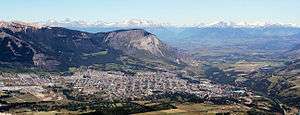
Aysén del General Carlos Ibáñez del Campo Region is subdivided into 4 provinces in which each province is divided into municipalities (communes).[12] There are a total of 10 municipalities in Aysén Region.[12]
| Aysén Province (capital: Puerto Aysén) | |||
| Aysén | Cisnes | Guaitecas | |
| Capitán Prat Province (capital: Cochrane) | |||
| Cochrane | O'Higgins | Tortel | |
| Coyhaique Province (capital: Coyhaique) | |||
| Coyhaique | Lago Verde | ||
| General Carrera Province (capital: Chile Chico) | |||
| Chile Chico | Río Ibáñez, Chile | ||
History
Early inhabitants
The earliest historically known inhabitants of the fjords and channels of Aysén Region are the Chono and Kawésqar. These two groupss shared a life style as canoe-faring hunther-gatherers. They also shared physical traits such as being of low stature, long-headed (Dolichocephalic) and having a "low face".[13] Despite similarities their languages were completely different.[14] The Chono moved around in the area from Chiloé Archipelago to 50° S and the Kawésqar from 46° S to the Strait of Magellan. Thus both groups overlapped in Gulf of Penas, Guayaneco Archipelago and other islands.[14] Yaghans inhabited a reduced area south of Tierra del Fuego.[14] Both Chonos and Kawésqar used Pilgerodendron uviferum as firewood as well as wood for rows, boats and houses.[15]
Guaitecas Archipelago made up the southern limit of Pre-Hispanic agriculture[16] as noted by the mention of the cultivation of potatoes by a Spanish expedition in 1557.[17]
Colonial era
Pedro de Valdivia sought originally to conquer all of southern South America to the Straits of Magellan (53° S). He did however only reach Reloncaví Sound (41°45' S). Later in 1567 Chiloé Archipelago (42°30' S) was conquered, from there on southern expansion of the Spanish Empire halted. The Spanish are thought to have lacked incentives for further conquests south. The indigenous populations were scarce and had ways of life that differed from the sedentary agricultural life the Spanish were accostumed to.[18] The harsh climate in the fjords and channels of Patagonia may also have deterred further expansion.[18] Indeed, even in Chiloé did the Spanish encounter difficulties to adapt as their attempts to base the economy on gold extraction and a "hispanic-mediterranean" agricultural model failed.[19]
During colonial times, the fjords and channels of Patagonia were first explored by the Spaniards. There were a number of motivations for their explorations, including a desire to Christianize indigenous peoples, to prevent intrusions of foreign powers into territory claimed by Spain, to increase geographic knowledge of the zone, and finally, to search for a mythical city called City of the Caesars.[20] False rumours of European settlements near the Straits of Magellan led the Spanish to organize the Antonio de Vea expedition of 1675–1676 which was the largest expedition to the date.[21][18] In 1792, the viceroy of Peru ordered the exploration of the Patagonian channels in order to find an entrance to the interior of Patagonia.[20] The said order was carried of by José de Moraleda who led an expedition that visited many of the main channels of the zone.[20]
Following the decline of the Chono populations in the archipelago in the 18th century, the area gained a reputation of "emptyness" among Chileans akin to the description of eastern Patagonia as a "desert."[22] However, the islands were often visited and traversed in the 19th century by fishermen, lumberjacks, and hunters from Chiloé.[22] This makes it clear that many areas that were traversed by explorers were already known to the inhabitants of southern Chiloé who visited these areas for wood, fish or hunting.[23][22]
Over-all the physical infrastructure of the Spanish in the fjords and channels during the colonial period was negligible and consisted of a few chapels built in the 1610s and 1620s and a wooden fortress built in 1750.[18] All these buildings were abandoned after a few years.[18]
Becoming part of Chile
The Aysen region was the last to be joined to Chile, long after even the southernmost region of Magallanes and Chilean Antarctica. Its geographical location and transport difficulties explain the lack of interest aroused in the nineteenth century for these lands, to the point that no one even thought of colonizing them with immigrants, as happened with the other southern regions.
In 1870 Aysén Fjord was explored by Enrique Simpson onboard Chacabuco discovering its usfullness to access more inland locations.[24]
Following the signing of the Boundary Treaty with Argentina in 1881, European settlers came from the Pampas to the valleys that cross the Andes from east to west. This private efforts led to the uncoordinated creation of cities in Puerto Aysen in 1904, Balmaceda and Coyhaique in 1917 and 1929. The oldest of the towns is Melinka, established by mid-nineteenth century, on Ascension Island of Guaitecas Archipelago.
The indigenous population was sparse. In the insular region, the Guaitecas and Chonos inhabited the Chonos Archipelago. They are believed to have become extinct in the 20th century. In the archipelagos south of the Gulf of Penas and to Tierra del Fuego lived the Alacalufes or Kaweshkar, also fishermen. Both groups were quickly decimated by disease and attacks by settlers in the late 19th century coming from southern Chile and Europe, a great number were from Germany, Switzerland, Austria, former Yugoslavia, Italy, Spain, the Netherlands, Denmark and the United Kingdom. Large numbers of Russians, Croats, Scots, Welsh and Irish arrived by government invitation and land sale programs to assist in the population of southern Chile and to reduce the number of indigenous peoples.
See also
- Aisén (disambiguation)
References
- "Sub-national HDI - Area Database - Global Data Lab". hdi.globaldatalab.org. Retrieved 2018-09-13.
- "About". Energía Austral. Aysén Region, Chile. Archived from the original on 9 December 2014. Retrieved 26 July 2012.
[...] will be located in the Aysén municipal district of the Aysén del General Carlos Ibáñez del Campo Region and will provide Chile [...]
- Arismendi S, Nolberto; Nancy Andrade S; Ricardo Riegel Sch; Roberto Carrillo Ll (2010). "Presence of a Phytoplasma Associated with Witches-Broom Disease in Ugni molinae Turcz. and Gaultheria phillyreifolia (Pers.) Sleumer Determined by DAPI, PCR, and DNA Sequencing". Chilean Journal of Agricultural Research. 70 (1). doi:10.4067/S0718-58392010000100003. ISSN 0718-5839.
[...] murta has been reported from the Maule Region to Aysén del General Carlos Ibáñez del Campo Region (Seguel and Torralbo, 2004).
- Examples of name usage: 1 Archived January 3, 2012, at the Wayback Machine, official regional government site refers to the region as "Región de Aysén".
- 2 Archived 2012-08-14 at the Wayback Machine, Chile's official meteorological agency refers to the region as "Región de Aisén".
- 3 Chilean government official website refers of Pilar Cuevas Mardones as intendant of "Región de Aysén" .
- 4 Chile's Ministry of Public Works calls the region "Región de Aysén" in the title of their 2011 report on that region.
- 5 Archived August 6, 2012, at the Wayback Machine, Corporación Nacional Forestal, a government agency refers to the region as "Región de Aysén" in their homepage.
- I, The Guardian reports on the 2012 Aysén protest.
- II, Santiago Times, a local English language newspaper use "Aysén Region" in a note referring to the same protest.
- III Santiago Times again.
- Pankhurst, R.J; Hervé, F; Rojas, L; Cembrano, J (1992), "Magmatism and tectonics in continental Chiloé, Chile (42°–42°30′S)", Tectonophysics, 205 (1–3): 283–294, doi:10.1016/0040-1951(92)90431-5
- V scientific paper in Journal of Hospital Infection referring to the region as "Aysen Region".
- "Decreto Ley 2339. Otorga denominación a la Región Metropolitana y a las regiones del país, en la forma que indica". Ley Chile (in Spanish). Biblioteca del Congreso Nacional de Chile. 10 October 1978. Retrieved 26 July 2012.
- Compendio Estadístico (in Spanish), Instituto Nacional de Estadísticas, 2006, pp. 75–77
- "Clima y vegetación Región de Aysén" (in Spanish). Biblioteca del Congreso Nacional. Retrieved October 20, 2015.
- "DESCRIPCIÓN CLIMATOLÓGICA" (in Spanish). Dirección General de Aeronáutica Civil. Retrieved October 20, 2015.
- "Clima: Región de Aisén" (in Spanish). Castor y Polux Ltda. Retrieved October 20, 2015.
- Saavedra G., Gonzalo (2007). "Prácticas Económicas en las Costas Insulares de Aisén. Testimonios de Persistencia y Transformación" (PDF). Actas del 6º Congreso Chileno de Antropología. VI Congreso Chileno de Antropología (in Spanish). Valdivia: Colegio de Antropólogos de Chile A. G. pp. 1696–1703.
- Saavedra Gallo, Gonzalo (2011). "Tensiones modernizantes y condicionantes culturales del desarrollo en el borde costero del Sur Austral chileno" [Modernizing tensions and cultural conditioners of development in the south austral Chilean coastal seaboard]. Revista Lider (in Spanish). 19: 201–219.
- "¿Qué es el Gobierno Regional?" (in Spanish). Gobierno Regional de Aysén. Retrieved October 20, 2015.
- Trivero Rivera 2005, p. 42.
- Trivero Rivera 2005, p. 33.
- Molinet, Carlos; Solari, María Eugenia; Díaz, Manuel; Marticorena, Francisca; Díaz, Patricio A.; Navarro, Magdalena; Niklitschek, Edwin (2018). "Fragmentos de la historia ambiental del sistema de fiordos y canales nor-patagónicos, Sur de Chile: Dos siglos de explotación". Magallania (in Spanish). 46 (2): 107–128. doi:10.4067/S0718-22442018000200107.
- Bird, Junius (1946). "The Alacaluf". In Steward, Julian H. (ed.). Handbook of South American Indians. Bulletin 143. I. –Bureau of American Ethnology. pp. 55–79.
- Contreras, Andrés; Ciampi, Luigi; Padulosi, Stefano; Spooner, David M. (1993). "Potato germplasm collecting expedition to the Guaitecas and Chonos Archipelagos, Chile, 1990". Potato Research. 36 (4): 309–316. doi:10.1007/BF02361797.
- Urbina Carrasco, Ximena (2016). "Interacciones entre españoles de Chiloé y Chonos en los siglos XVII y XVIII: Pedro y Francisco Delco, Ignacio y Cristóbal Talcapillán y Martín Olleta" [Interactions between Spaniards of Chiloé and Chonos in the XVII and XVII centuries: Pedro and Francisco Delco, Ignacio and Cristóbal Talcapillán and Martín Olleta] (PDF). Chungara (in Spanish). 48 (1): 103–114. Retrieved December 21, 2019.
- Torrejón, Fernando; Cisternas, Marco; Alvial, Ingrid and Torres, Laura. 2011. Consecuencias de la tala maderera colonial en los bosques de alece de Chiloé, sur de Chile (Siglos XVI-XIX)*. Magallania. Vol. 39(2):75–95.
- Morales Matos, Guillermo (1996), "Conflictos geográficos en las tierras patagónicas chilenas", Ería: Revista Cuatrimestral de Geografía, 41: 206–212, retrieved 12 September 2013
- Martinic B., Mateo; Moore, David M. (1982). "Las exploraciones inglesas en el estrecho de Magallanes. El mapa manuscrito de John Narborough" (PDF). Anales del Instituto de la Patagonia (in Spanish). 13: 7–20. Retrieved December 21, 2019.
- Núñez, Andrés G.; Molina O., Raúl; Aliste A., Enrique; Bello A., Álvaro (2016). "Silencios geográficos de Patagonia-Aysén: Territorio, nomadismo y perspectivas para re-pensar los margenes de la nación en el siglo XIX" [Geographical silences in Patagonia-Aysén: Territory, nomadism and perspectives for re-thinking the margins of Chile in the nineteenth century]. Magallania (in Spanish). 44 (2): 107–130. doi:10.4067/S0718-22442016000200006.
- Bello Maldonado, Álvaro (2017). "Exploración, conocimiento geográfico y nación: La "creación" de la Patagonia Occidental y Aysén a fines del siglo XIX" (PDF). In Núñez, Andrés; Aliste, Enrique; Bello Maldonado, Álvaro; Osorio, Mauricio (eds.). Imaginarios geográficos, prácticas y discursos de frontera: Aisén-Patagonia desde el texto de la nación. GEOlibros (in Spanish). Impresión Gráfica LOM. pp. 61–86. ISBN 978-956-14-2064-9.
- Simpson, E. (1874). Esploraciones hechas por la Corbeta Chacabuco al mando del capitán de fragata don Enrique M. Simpson en los Archipiélagos de Guaitecas, Chonos i Taitao. Santiago. Imprenta Nacional.
- Bibliography
- Trivero Rivera, Alberto (2005). Los primeros pobladores de Chiloé: Génesis del horizonte mapuche (in Spanish). Ñuque Mapuförlaget. ISBN 91-89629-28-0.
External links
| Wikivoyage has a travel guide for Aysén. |
- (in Spanish)—Goreaysen.cl: Official Aysén Region website
